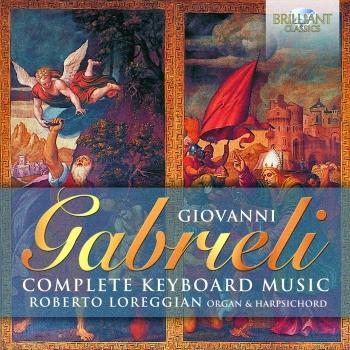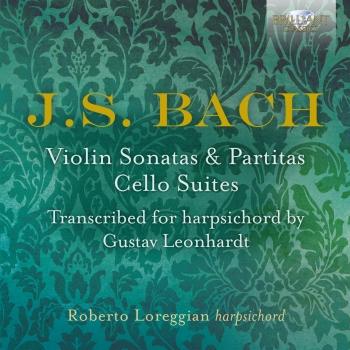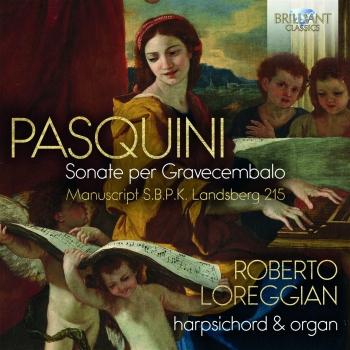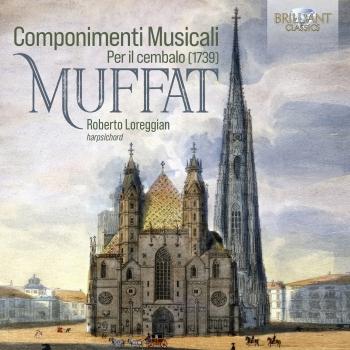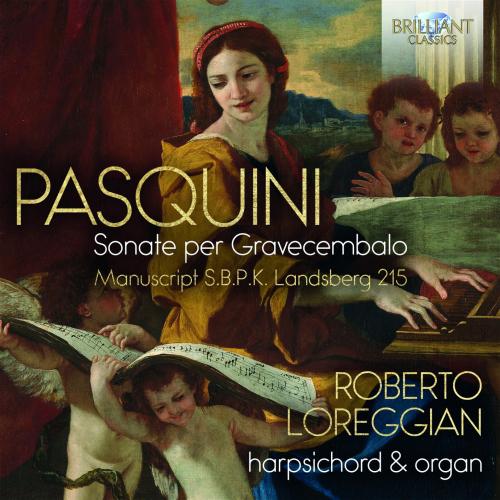
Pasquini: Sonate per Gravecembalo Roberto Loreggian
Album info
Album-Release:
2019
HRA-Release:
20.12.2019
Label: Brilliant Classics
Genre: Classical
Subgenre: Chamber Music
Artist: Roberto Loreggian
Composer: Bernardo Pasquini (1637-1710)
Album including Album cover
- Bernardo Pasquini (1637 - 1710):
- 1 Fantasia la, mifa fa 07:11
- 2 Variazioni d'invenzione in D. sol re 20:35
- 3 Canzona francese in c. sol fa ut 02:55
- 4 Toccata in f. fa ut 04:06
- 5 Canzona francese in f fa ut 02:16
- 6 Fantasia in e, la, mi 03:17
- 7 Corrente con variazione in A. la, mi, re 02:10
- 8 Capriccio in G. sol, re, ut 04:54
- 9 Capriccio breve in G. sol, re, ut 02:29
- 10 Bergamasca 02:17
- 11 Sarabanda 02:27
- 12 Partite diverse sopra allemande 13:21
- 13 Canzona francese 06:40
- 14 Variazioni 23:44
- 15 Variazioni per fiorenza 07:47
- 16 Tastata per l'inglese 02:37
- 17 Toccata seconda 02:08
- 18 Tastata quarta per francia 02:49
- 19 Variazioni per francia 05:04
- 20 Toccata quinta 03:49
- 21 Toccata sesta 00:48
- 22 Toccata settima 02:04
- 23 Toccata ottava 03:14
- 24 Tastata per l'inglese (2) 01:47
- 25 Alemanda per l'inglese di scozia - altre di seguito 04:49
- 26 Toccata per Monaco 06:23
- 27 Variazioni capricciose in C. sol fa ut 09:44
- 28 Ricercare con la fuga in più modi 17:20
- 29 Ricercare in D. sol re 05:07
- 30 Toccata terza 02:19
- 31 Partite diverse di follia 07:43
- 32 Toccata per lo scozzese 02:37
- 33 Passagagli per petronilla 02:52
- 34 Variazioni per petronilla 07:58
- 35 Variazioni (2) 14:02
- 36 Variazioni per il paggio todesco in G Minor 04:28
- 37 Mandata in Germania al baron d'artich - Al medesimo 01:57
- 38 Tastata per lo scozzese 02:47
- 39 Altra toccata per il medesimo 02:40
- 40 Allemanda per il danese - Per il medesimo - Per il medesimo -Per il medesimo - Per il medesimo - Per il medesimo 06:27
- 41 Altra per me - Bizzarria 00:40
- 42 Tastata per il signor Melani per Genova 02:06
- 43 Tastata per milone 02:14
- 44 Tastata per milone (2) 02:03
- 45 Bizzarria 00:50
- 46 Per milione 00:57
- 47 Alemanda per lo scozzese 01:32
- 48 Partite del saltarello 03:26
- 49 Tastata scozzese 02:20
- 50 Alemanda per lo scozzese 05:02
- 51 Alemanda scozzese - Corrente 04:04
- 52 Tastata 02:32
- 53 Alemanda - Corrente 02:56
- 54 Altra alemanda - Corrente 03:44
- 55 Altra - Alemanda 01:36
- 56 Alemanda 01:59
- 57 Bizzarria (2) 01:21
- 58 Alemanda - Corrente 03:21
- 59 Bizzarria (3) 00:46
- 60 Partite di bergamasca 04:15
- 61 Alemanda IX - Corrente - Altra 03:51
- 62 Alemanda per la medesima - Altra - Altra - Altra - Altra 04:08
- 63 Altre (variazioni) per la medesima 02:56
- 64 Toccata con lo scherzo del cucco per lo scozzese 05:32
- 65 Toccata ad istanza del melani 02:07
- 66 Toccata per spagna 03:41
- 67 Toccata per milone 02:56
- 68 Aria 00:57
- 69 Per lo scozzese 00:51
- 70 Alemanda (2) 02:57
- 71 Passagagli per lo scozzese 03:32
- 72 Bizzarria - Variazione 01:48
- 73 Alemanda VIII - Corrente - Altra 07:04
- 74 Toccata 03:11
- 75 Alemanda X - Corrente 04:36
- 76 Fuga per D. Giovanni Ruffo 01:56
- 77 Aria allegra - Aria - Altra - Altra - Aria per il nipotino di Mons. Ruffo -Altra per il medesimo - Altra per il medesimo 05:27
- 78 Passagagli per il nipotino di Mons. Ruffo 01:42
- 79 Aria Prima - Aria Seconda - Aria Terza - Aria Quarta - Aria Quinta -Aria Sesta - Aria Settima - Aria ottava 07:44
Info for Pasquini: Sonate per Gravecembalo
This exciting release presents recently discovered works from the baroque composer Bernardo Pasquini. Brought to you by early music specialist Roberto Lorregian (Albinoni: 12 Cantatas for Soprano and Contralto Op.4, BC95600), the works in this set come from the Landsberg 215 manuscript, written between 1691 and 1702.
Pasquini (1637–1710) spent most of his life in Italy, working first as an organist for the Arciconfraternita della Morte in Tuscany, following in the footsteps of Girolamo Frescobaldi and Luzzasco Luzzaschi. He later moved to Rome to work as an organist at Santa Maria in Vallicella and worked for Pope Alexander VII at the Basilica of Santa Maria Maggiore, before he was hired by Prince Giovanni Battista Borghese. Word of Pasquini’s exceptional talent as an organist and harpsichordist travelled beyond the borders of his home country, andcommissions flooded in from wealthy patrons including the cardinals Flavio Chigi, Benedetto Pamphilj and Pietro Ottoboni, Queen Christina of Sweden, Prince Lorenzo Onofrio Colonna and the Duke of Modena Francesco II d’Este.
The compositions in Landsberg 215 were likely used for educational purposes. Performed in order, the first CD contains pieces in an imitative contrapuntal style, followed by a study of different genres. The final CD features traditional 17th-century instrumental music. Their titles indicate the recipients of the pieces, for example Allemanda per il Danese (for the Dane), or the piece’s destination Toccata per Spagna (for Spain). Sometimes we can more accurately identify the receiver of the piece: Toccata con lo scherzo del cucco was gifted to John Clerk, the baronet of Penicuik, a Scottish nobleman who met the composer during a trip to Rome and who was also tutored by Angelo Corelli. Interestingly, Pasquini has added a personalised touch to Clerk’s piece: ‘Penicuik’ in ancient Celtic means ‘cuckoo hill’, and the main theme of the piece is a descending minor third, much like the call of the cuckoo.
In this performance Roberto Lorregian recreates the sound of late-17th-century Italy, playing a copy of a harpsichord by Rome-based maker Giovanni Battista Giusti and the 1713 G. Bonatti organ at Rezzato in northern Italy. This set offers us a fine example of baroque keyboard music and an insight into Pasquini’s life as a teacher, whose monumental influence radiated across Europe.
Bernardo Pasquini (1637-1710) was an Italian composer of opera and church music. A renowned virtuoso keyboard player in his day he was one of the most important Italian composers for harpsichord and organ between Frescobaldi and Scarlatti.
This new recording on 5 CDs offers the complete works for keyboard, a sumptuous collection of diverse musical forms like Toccata, Partita, Variations, Ricercares, Canzonas, Passacaglias and separate dance forms like Allemande and Corrente. The music is in rich Italian style with the emphasis on melody and cantilena.
Roberto Loreggian plays alternatively on harpsichord and organ, a Bonatti di Rezzato instrument from 1713.
Roberto Loreggian is one of the foremost keyboard players of Italy. He successfully recorded complete keyboard cycles by Frescobaldi, Gabrieli, Galuppi and others.
Roberto Loreggian, harpsichord, organ
Roberto Loreggian
Having achieved, with the highest grades, a diploma in organ and harpsichord, he perfected his talents at the Conservatory of The Hague (NL) under the direction of Ton Koopman. His activities led him to perform in the most important halls: Parco della Musica - Rome, Sala Verdi - Milan, Hercules Saal - Munich (Germany), Teatro Colon - Buenos Aires, Kioi Hall - Tokyo... at highly important festivals: MITO, Sagra Malatestiana (Malatestiana Festival), Pergolesi Spontini Festival, Accademia di Santa Cecilia, musical evenings... performing both as a soloist accompanist and soloist with numerous orchestras, Orchestra dell'Accademia di Santa Cecilia, Chamber Orchestra of Mantova, the Orchestra of Padua and the Veneto, I Virtuosi Italiani, L'Arte Dell'Arco, I Barocchisti... He has recorded numerous CDs for record labels such as Chandos, Tactus, Arts... which have been internationally acclaimed. He has recorded the complete collection of keyboard music by G. Frescobaldi for the label 'Brilliant' winning the 'National Award for Classic Music Track 2009', for the same label he recorded the complete keyboard music of A. Gabrieli, the complete Harpsichord concerts of B. Galuppi and the harpsichord music of G. F. Haendel. His recordings devoted to harpsichord music by B. Pasquini (Chandos Chaconne) and by G. B. Ferrini (Tactus) received the award 'Preis der Deutschen Schallplattenkritik'. He teaches at the Conservatory 'C. Pollini' in Padova, Italy.
This album contains no booklet.









